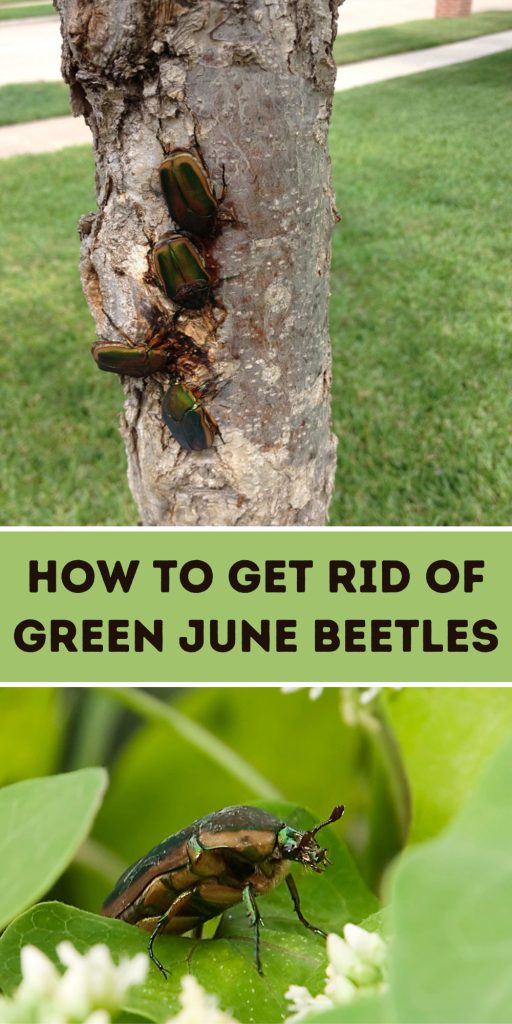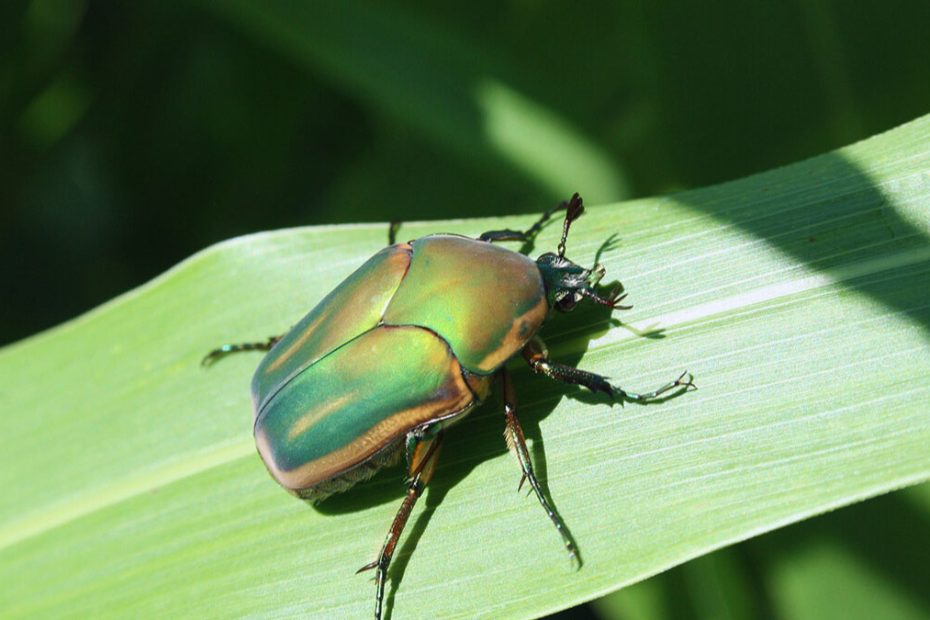Green June beetles can wreak havoc on your garden, turning your lush greenery into a feeding ground. These iridescent pests are not just an eyesore; they can cause significant damage to your plants and lawn. If you’re tired of watching your hard work get devoured, it’s time to take action.
Understanding the habits and lifecycle of Green June beetles is crucial for effective control. By targeting both the adult beetles and their larvae, you can protect your garden and restore its beauty. In this guide, you’ll learn practical and proven methods to get rid of these pesky invaders for good.
Key Takeaways
- Understanding Green June Beetles: Recognize the beetles’ appearance, lifecycle, and feeding habits to implement effective control measures in your garden and lawn.
- Identifying Infestations: Learn the signs of a Green June beetle infestation, including damaged turf, noisy flight, and ripe fruit damage, to address issues early.
- Natural Remedies: Utilize beneficial insects like tachinid flies and parasitic wasps, as well as homemade sprays, to control beetle populations naturally and safely.
- Chemical Solutions: Apply recommended insecticides such as carbaryl, imidacloprid, and chlorantraniliprole accurately and safely for severe infestations.
- Preventing Future Infestations: Maintain a healthy lawn through aeration, mowing, and proper watering, and create unfavorable conditions using soil amendments, mulching, and beneficial nematodes.

Understanding Green June Beetles
Green June beetles are commonly found in the eastern and central United States. These beetles, also known as Cotinis nitida, are large, metallic green insects that can be a nuisance to gardens and lawns.
Key Characteristics and Lifecycle
Green June Beetles:
- Appearance: Metallic green body with copper-colored wings.
- Size: Usually about 0.75 to 1 inch long.
Lifecycle:
- Eggs: Females lay eggs in moist, sandy soil during midsummer.
- Larvae: These white grubs develop over several weeks, feeding on roots and organic matter.
- Pupae: Larvae pupate in the soil during late spring.
- Adults: Emergence begins in early summer, with adults active until late August.
Feeding Habits
Green June beetles are primarily scavengers but can damage gardens and lawns:
- Larvae: Feed on roots of grasses and other plants, disrupting turf.
- Adults: Consume ripe fruits, such as grapes and peaches, and sometimes flowers.
Identifying Green June Beetles
To ensure you’re dealing with Green June beetles, observe the following features:
- Flight Pattern: Adults fly noisily and erratically, often close to the ground.
- Grub Movement: Larvae crawl on their backs with stiff, bristled legs.
Impact on Gardens and Lawns
Their feeding habits can cause significant damage:
- Turf Damage: Grubs create dead patches in lawns by consuming roots.
- Fruit Destruction: Adults feed on fruits, leaving them damaged and unsellable.
Understanding these beetles’ habits and lifecycle is crucial for their effective management. Identifying them accurately can help you carry out appropriate control strategies to protect your garden and lawn.
Identifying Green June Beetle Infestation
To manage Green June beetles, it’s essential to recognize signs of an infestation and understand their common habitats.
Signs of Infestation
Identifying an infestation involves noting specific indicators:
- Damaged Turf: Look for areas where sod can be easily lifted, a sign that larvae have consumed roots.
- Noisy Flight: Observe adult beetles in flight during early summer. Their distinctive buzzing noise can help locate them.
- Ripe Fruit Damage: Check fruits like peaches, grapes, and figs for bite marks or significant damage.
- Bird and Mammal Activity: Increased activity from birds or mammals foraging in lawns can indicate larvae presence.
Common Habitats
Knowing where Green June beetles thrive can aid in early detection:
- Moist Soil: These beetles lay eggs in moist, well-irrigated soil, often found in gardens and lawns.
- Decaying Organic Matter: Infested areas usually have decaying vegetation or compost, which attracts both larvae and adults.
- Fruit Orchards and Vineyards: Orchards and vineyards provide ample food sources for adult beetles.
- Open Lawns and Fields: Larvae prefer open, grassy areas where the soil is moist and loose.
Identifying these signs and knowing preferred habitats helps you address Green June beetle infestations effectively.
Natural Remedies for Green June Beetles
Taking natural steps to control Green June beetles can be both effective and environmentally friendly. Here are some reliable remedies.
Beneficial Insects
Certain insects help reduce Green June beetle populations by preying on their larvae:
- Tachinid Flies: These parasitic flies lay eggs on adult beetles. Once hatched, larvae burrow into the beetle, eventually killing it.
- Parasitic Wasps: These wasps target beetle eggs and larvae. They lay their own eggs inside the beetle larvae, consuming them from within.
- Predacious Beetles: Certain beetles prey on Green June beetle larvae. Introducing these can help control the pest population.
Encouraging these beneficial insects in your garden:
- Plant a diverse range of flowers to attract them.
- Avoid using broad-spectrum insecticides that harm these helpful insects.
- Provide habitats, like small piles of leaves or stones, where beneficial insects can thrive.
Homemade Sprays
Natural sprays can deter and kill Green June beetles:
- Peppermint Oil Spray: Mix 10 drops of peppermint oil with 2 cups of water. Spray on plants to repel beetles.
- Garlic Spray: Crush several garlic cloves and steep them in 1 quart of water overnight. Strain and spray this mixture on affected plants to deter beetles.
- Neem Oil: Mix 2 tablespoons of neem oil with 1 gallon of water. This acts as both a repellent and insect growth regulator when sprayed directly on plants and beetles.
Steps to apply homemade sprays effectively:
- Spray in the early morning or late evening to avoid harming beneficial insects.
- Reapply after rain or heavy watering.
- Target areas where beetles are most active, such as near decaying organic matter or ripe fruits.
Using natural remedies helps manage Green June beetle infestations without harming the environment. Implementing these methods will protect your garden while supporting a healthy ecosystem.
Chemical Solutions and Pesticides
Dealing with Green June beetles, also known as Cotinis nitida, can be challenging. Chemical solutions and pesticides effectively reduce their population, especially in severe infestations. It’s important to select appropriate products and apply them correctly to protect your garden or lawn.
Recommended Products
Choosing the right pesticides is crucial in managing Green June beetles:
- Carbaryl: A broad-spectrum insecticide, effective against adult beetles. Apply it to foliage or soil for maximum impact.
- Imidacloprid: A systemic insecticide, it targets larvae. Apply it to infested turf to eliminate beetle grubs.
- Chlorantraniliprole: An insecticide targeting larvae. Use it on lawns to disrupt beetle development.
Provide specific product recommendations based on the target insect’s lifecycle stage for effective results.
Application Tips
Proper application techniques enhance pesticide effectiveness. Follow these tips for the best outcomes:
- Timing: Apply insecticides in early summer, targeting larvae stages for maximum disruption.
- Coverage: Ensure even distribution of carbaryl on foliage and soil to avoid missed areas.
- Weather Conditions: Apply insecticides during calm weather to prevent drift and ensure better adherence to plants.
- Safety: Always wear protective clothing and follow label instructions to avoid harm.
By selecting the right products and using correct application techniques, you can manage Green June beetle infestations effectively.
Preventing Future Infestations
Preventing future infestations of Green June beetles requires a proactive approach. Carry out strategies that make your garden and lawn less appealing to these insects.
Lawn Maintenance Tips
Maintaining a healthy lawn is key to deterring Green June beetles. Healthy turf is less susceptible to larvae damage.
- Aeration: Regularly aerate your lawn to reduce soil compaction and improve water and nutrient absorption.
- Mowing: Keep grass at an optimal length (around 2.5 to 3 inches) to discourage beetles from laying eggs.
- Watering: Water deeply but less frequently to promote deep root growth and reduce soil moisture that attracts beetles.
- Fertilization: Apply balanced fertilizers during the growing season to keep grass healthy and resilient.
Creating Unfavorable Conditions
Creating an environment that’s hostile to Green June beetles can help prevent infestations.
- Soil Amendments: Use lime or sulfur to adjust soil pH to levels unfavorable to beetles, typically around 6.0 to 7.0.
- Mulching: Apply a thick layer of mulch around plants to create a dry, less attractive environment for beetles to lay eggs.
- Beneficial Nematodes: Introduce nematodes like Heterorhabditis bacteriophora to naturally combat beetle larvae in the soil.
- Companion Planting: Plant beetle-repelling plants such as garlic, marigolds, and chives around your garden.
By following these lawn maintenance tips and creating unfavorable conditions for Green June beetles, you can significantly reduce the likelihood of future infestations.
Conclusion
Effectively managing Green June beetles requires a multifaceted approach. By understanding their habits and lifecycle, you can identify and address infestations early. Natural remedies and chemical solutions both offer viable options depending on the severity of the problem.
Proactive lawn maintenance and preventive measures play a crucial role in keeping these pests at bay. With the right strategies, you can protect your garden from damage while promoting a healthy ecosystem.
Frequently Asked Questions
What are Green June beetles?
Green June beetles, or Cotinis nitida, are large, metallic green insects commonly found in the eastern and central United States. They are known for their damage to plants and lawns.
How do Green June beetles damage gardens?
The larvae of Green June beetles consume turf roots, causing damage to lawns. The adult beetles damage ripe fruits and flowers by feeding on them.
How can I identify a Green June beetle infestation?
Signs of infestation include damaged turf, bite marks on fruits, and increased activity from foraging birds. You may also notice the beetles’ noisy flight and distinct movement of larvae.
Where do Green June beetles commonly live?
These beetles thrive in moist soil and fruit orchards, making such environments common habitats for them.
What natural remedies can I use to control Green June beetles?
Natural remedies include introducing beneficial insects and using homemade sprays. These methods are environmentally friendly and aim to control the beetle population.
Are chemical solutions effective for severe infestations?
Yes, chemical solutions like carbaryl, imidacloprid, and chlorantraniliprole are recommended for severe infestations. Proper application techniques are essential for effectiveness.
How can I prevent future infestations of Green June beetles?
Preventive strategies include aerating the lawn, maintaining optimal grass height, applying balanced fertilizers, adjusting soil pH, using mulch, introducing beneficial nematodes, and employing companion planting with beetle-repelling plants. These practices promote a healthy lawn and create unfavorable conditions for beetles.
